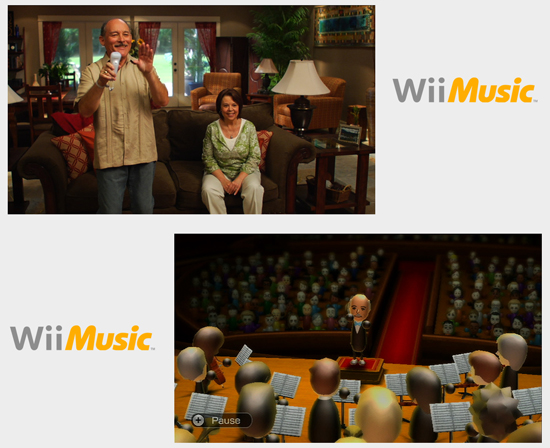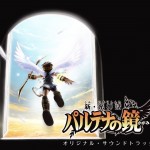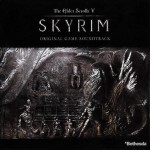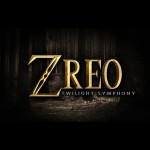I remember back at E3 2006 when the Wii was first shown, and what was effectively a technical demo titled “Wii Music” was on the floor. It featured simple yet addictive orchestral conducting gameplay, and I was immediately excited about the prospect of interacting with Nintendo’s classic game tunes. However, as Wii Music took shape at this year’s E3 as a free-for-all music experience, I think I was with many of you out there in being skeptical of Nintendo’s approach.
If you haven’t kept up on the details, the idea behind Wii Music is that there is no right or wrong way to perform a song. You’ll basically hold the Wii remote and nunchuck and simulate the motions of a slew of instruments, triggering notes whenever you’d like that match the pitch of the rest of the instruments being played. This is definitely not a conventional approach as it effectively removes the “game” out of Wii Music, but is this approach merely a gimmick or does it provide a truly innovative musical experience?
Read our full impressions of Wii Music after the jump.
The fact of the matter is there’s a whole lot to do in Wii Music. There’s a long list of songs to perform alongside a number of brilliant minigames. I should start with the main performance mode, however, as it’s the focus of the game.
Be prepared for a slow start. After a long tutorial, you can choose among a short list of songs and instruments to get your feet wet with the “music is whatever you want it to be” philosophy. The initial set of songs includes greats like “Twinkle Twinkle Little Star” and “Do-Re-Mi,” which I’m sure already have you excited, but as you progress, you unlock more songs, instruments, and even some lessons that will teach you how to dig even deeper into Wii Music if you so wish.
Again, the whole game is designed to let players decide when to play notes. You’ll first choose which section you want to play (melody, harmony, percussion, etc.), and based on the instrument you select, you position the remote and nunchuck in one of four configurations and play your part along with miniature-sized “Tute” people who fill in the other sections. The configurations include piano, which requires you to bang your fists up and down like a madman, guitar, where players hold the nunchuck out like the neck of a guitar while strumming with the Wii remote (this is the hardest one), flute, where you’ll hold the remote to your face while pressing the 1 and 2 buttons to play notes, and violin, where button presses on the nunchuck trigger notes. If you want to mix it up a bit, you can also hold on the A or B buttons while making these various motions to create different sounds with each instrument.
From there, it’s finally on to the song. Are you afraid that you won’t know what to do without any sort of direction to guide you through the tunes? I know I was. Thankfully you can toggle on and off a music sheet that shows you what the regular pattern of notes would be for that given section, giving you a guideline to improvise on if you so wish. While this is a simple feature, I don’t think I would have had as much fun with Wii Music without it.
After completing a song, you can create a music video, complete with your own album art, which is oddly one the best parts of the game. You can take images of yourself and the other band members and move them around, take on different poses, make them smaller, bigger, upside down, etc., and I found myself spending a lot of time creating some pretty ridiculous cover art. After that, you can watch the video of your performance if you’d like, although I find it kind of boring to watch when you could be playing again.
So, how about the song list? Like I said, the first set is somewhat uninspiring. You get “Twinkle Twinkle Little Star,” “Do-Re-Mi,” and some others, but as you progress, you unlock a host of classical tunes, traditional songs from around the globe, and even some game tracks. Honestly, I was mainly after the game tracks, which include “Mute City” from F-Zero, the Wii Sports theme, Super Mario Bros 1-1, The Legend of Zelda theme, and a few tracks from Animal Crossing. Some other favorites of mine are “September” by Earth, Wind, and Fire and “Wake Me Up Before You Go-Go” by Wham!, but the remainder of the over 50 songs had me less than excited. However, it’s important to note that Wii Music wasn’t created for people like me, so it’s likely that some of the more traditional tunes will appeal to a younger audience. This would have been the perfect game for the Pay-To-Play DLC service, but we’ve yet to hear about this service for Wii Music, and the absence of the PTP logo doesn’t bode well for it’s future inclusion.
To get the most out of your songs, you’re going to want to create different arrangements. You can select predetermined groups of instruments for you and the Tutes to use by genre, including jazz, Latin, Japanese, and a horrendous take on electronic music, but you’ll most likely want to create your arrangements manually if you want unique results. You can choose from over 60 instruments, including various flutes, guitars, pianos, and even some crazy things like cats, dogs, rappers, and karate masters, and perform any of the sections along with the Tutes. However, to create an entirely new arrangement, you can select and instrument and record each individual part yourself by playing through multiple times and playing over your previous performance to create an all new and unique arrangement of any song in the game. This is particulary fun with the “NES Horn” instrument that lets you turn any song into a chip tune.
Wii Music is obviously meant to be interactive, and whenever players enter the main menu by either loading the game or completing a jam, a random quartet of Miis from your library (who are also featured in the audiences throughout the game) are featured performing the Wii Music theme. Based on the instrument your Mii is holding in the group, you can hold the Wii remote and nucnhuck in the proper configuration and start jamming away with the band on the fly, and this is all in the menu screen! I spent ridiculous amounts of time screwing around in the menus for this reason, as the song is insanely addictive. The catchy theme is also arranged in many ways throughout some of the non-interactive menus in the game as well, which is a nice touch.
I mentioned those brilliant mini-games earlier. The first mini-game is actually the orchestra conductor game from the E3 demo in 2006, now titled “Mii Maestro.” There are five songs available in this mode, including The Legend of Zelda, with the ensemble following the tempo you set by waving the Wii remote back and forth (or in proper conducting motions if you prefer). Another mini-game, “”Handbell Harmony,” puts you in a group with a number of Tutes who have different colored bells. As the music scrolls from left to right, the colored bells appear, and you simply shake your remote or nunchuck whenever that colored note comes up.
Finally, although it doesn’t involve performing music, “Pitch Perfect” is a quiz game that tests your ability to detect pitch and rhythm. There are 8 levels of difficulty, each of which consists of ten activities that include locating the two Miis who are playing the same note, locating the lowest/highest pitch among the group of Miis, picking the Miis who are creating a given chord, or figuring out which Mii is playing an incorrect note in the group. I can’t stress how much fun this is, and the fact that you’re racing against the clock and are assigned points based on how much time you have left makes it pretty competitive as well.
Without these mini-games, I think I would have personally been disappointed with Wii Music. As a music lover, I was hoping for a little more in terms of music selection at the very least. I can forgive the variable quality MIDI sounds when it comes to the instruments, but everyone knows that song selection is vitally important to music games. There are only a handful of tracks that I’d care to check out again, but the remainder I was hesitant to try even the first time. Again, I’ll reiterate that the target audience for Wii Music is not people like me. It’s the casual gamer or perhaps the kid who might have more familiarity with these songs and isn’t particularly interested in the latest top 40. We have to admit that there aren’t a whole lot of people out there who would appreciate a large selection of classic Nintendo songs, although some Metroid music would have been great. I hope they consider the Pay-To-Play service for Wii Music, as it would really open the game up to crowds with specific tastes.
Overall, Wii Music is an interesting experience. It’s something that in some ways is pure genius. You’ll want to show it to your friends when they come over. Perhaps jump in and do a quick jam of the Mario theme of Zelda theme with your friends. It’s not really meant to be a serious rhythm game, which is apparent from nearly every design choice, so I’m willing to accept it for what it is. You should at least check out the mini-games if you get the chance, as I’d gladly slap down fifty bucks for a Wii Music spin-off that was solely focused on the “Mii Maestro” and “Pitch Perfect” modes alone. I imagine the game (or non-game?) will be a hit this holiday season, and with good reason. Nintendo knows exactly what it’s doing, even if it doesn’t initially appeal to the hardcore music fan in this instance. Everyone will find something they like in Wii Music; it may just take some longer than others to find something worthwhile.
Would you like to see a Pay-To-Play (DLC) service for Wii Music? What do you think about this unique approach to music-based gameplay?
Tags: Nintendo, Reviews, Rhythm, Videogame, Wii Music









































[…] Full review here […]
good review
[…] Originalsoundversion (Not Positive): “There are only a handful of tracks that I’d care to check out again, but the remainder I was hesitant to try even the first time. Again, I’ll reiterate that the target audience for Wii Music is not people like me.” […]
Great review. Very informative and just the right amount of detail in my opinion!
One of the better reviews that I’ve read this evening. As someone who is considering this game, I appreciate the details.